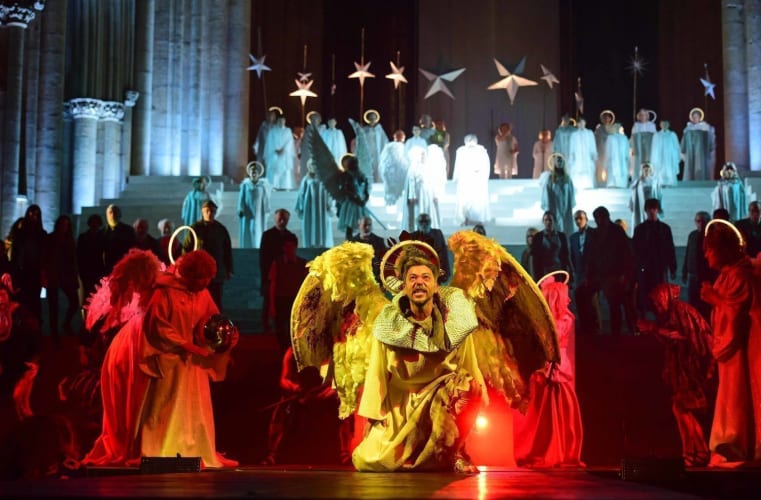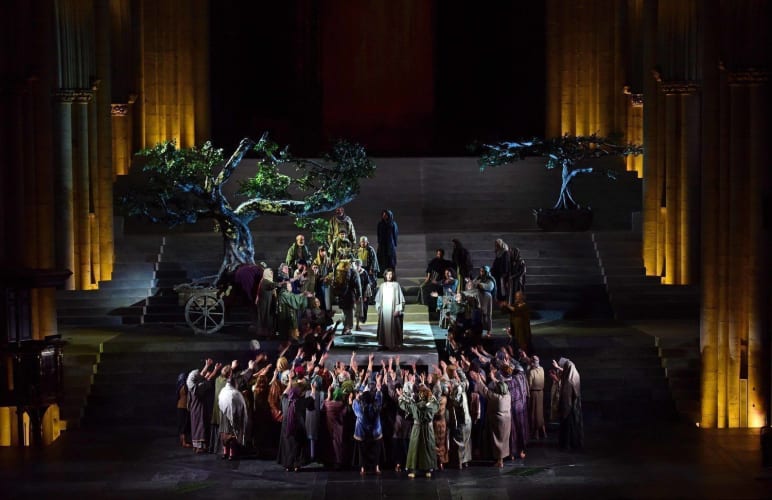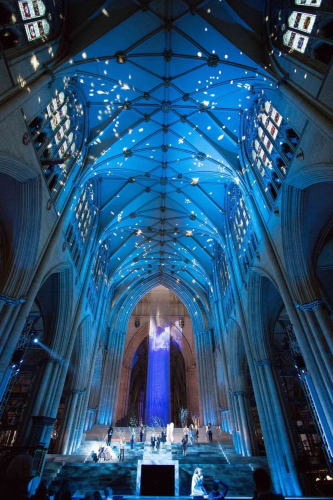Four years on from the 2012 Mysteries, co-produced by York Theatre Royal, Riding Lights Theatre Company and York Museums Trust, and sixteen years after the Greg Doran-directed Millennium Mysteries, the plays have returned to the massive, aweing scale of the Minster.
With nearly 150 actors and a month's worth of performances (to a massive, purpose-built, thousand-seater auditorium), the size of the Minster and the sweep of the stories are not the only 'epic' things about this undertaking.
As has become traditional, all but a few of the performers and crew are unpaid volunteers, and this mass community involvement enables director Phillip Breen to populate the stage with impressive crowd-driven set-pieces.
The production returns to the text created by Mike Poulton for the Millennium Mysteries. Derived from medieval waggon plays, in which each biblical story would be told by a different guild around the city (in all taking almost a whole day), this adaptation compresses the action of four dozen of these playlets into a single show. It maintains much of the evocative Yorkshire vocabulary of the compulsively rhyming and alliterative Middle English texts, so God's might is 'full mickle', and the Roman authorities refer to Jesus as a 'gadabout lad'.
This is not as streamlined as Mike Kenny's 2012 adaptation: Breen's production clocks in at just less than four hours, which may deter some theatregoers. But it must be said that the constant generation of imaginative and vibrant imagery on a massive scale is enough to maintain the attention.
It's the design which, for me, is the star here. Max Jones and Ruth Hall's intelligent work fills the voluminous vertical space of the Minster's nave with towering steps, an immense banner mirroring the building's columns, and even, during the Creation, large, glowing, helium-filled planets. Backed with live orchestral and choral music created by Richard Shephard, these moments are often magical and generate the sense of reverence and wonder fitting of the subject matter.
Ian Small opens the evening, playing God with benevolence, clarity and calm. He sets in motion the story of the Creation and subsequent Exodus from Eden. Breen's use of the space cleverly moves from sparse vasty voids to densely populated crowds, and the story of Noah and the Flood, for instance, gives us streams of cleverly designed animal costumes marching into the hastily-constructed Ark before a deluge of blue satin transforms the massive stage.
Maurice Crichton pops up as a broad Yorkshire Herod, with a gold cape to rival the floods and an entrance to make a pantomime villain green with envy. Later we see Philip Massey nicely differentiated from this as Pontius Pilate, played straight and stentorian. Unfortunately, his soldiers, like the shepherds before them, follow in another grand tradition: the working class comic relief fails to translate over the centuries, as in countless modern Shakespearean productions as well.
When the one paid actor, Philip McGinley, turns up as Jesus towards the end of the long first half, he exudes a power and serenity befitting the character. It helps that McGinley demonstrates perfect vocal mastery, exuding a beatific calm through his rich tones. It probably also helps that he gets his top off within a minute of his appearance, much to the swooning delight of a few (presumably) Game of Thrones fans around me.
Shirt or no shirt, he is splendid, and takes up his role with controlled skill. The part is, appropriately, something of a cipher for audiences (whether they profess a faith or not) to project onto.
But it's advisedly that I refer to him as the paid actor, rather than the professional one. There is a depth of talent within the cast, none more captivating than Toby Gordon as Lucifer. In the role, Gordon channels the purposeful swagger required to play the Devil on a stage of this scale. He is powerful and malevolent, and his final appearance (again aided by skilful design and costume work) is genuinely demonic.
Tina MacHugh’s lighting design deserves applause, too, for its imagination and clarity of purpose. Often the immense steps are divided cunningly into several layers of lights, so towards the climax the angels are doused in warm yellowy hues as Jesus ascends to join them, lit in a more searing, pure white, and the humans below watch on bathed in subtly more earthly tones.
It is a production of memorable spectacle, then, and sufficiently fast-paced (just) to maintain the interest over its long running time and through what might otherwise risk becoming a sequence of tableaux vivants, albeit imaginative and impressively mounted ones.


